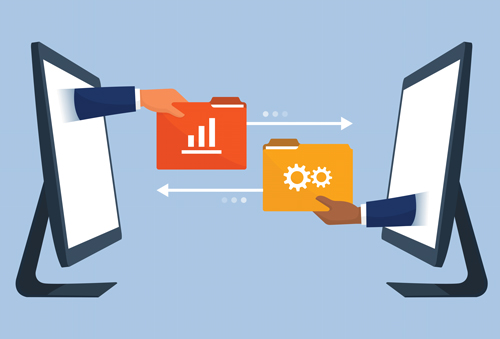Key Technologies Driving Network Transformation

Introduction
As the digital landscape evolves at a breakneck pace, the imperative for businesses to undergo network transformation has never been more critical. This transformation is not merely an upgrade but a complete overhaul of traditional network infrastructures using the latest in technology. These changes are essential for businesses looking to enhance efficiency, scale effectively, and bolster security in response to the demands of modern digital operations, including cloud technology, big data, and the Internet of Things (IoT). This article delves into the pivotal technologies driving this digital transformation, detailing their roles and the significant impact they have on contemporary business networks.
Understanding Network Transformation
Network transformation refers to the comprehensive process of updating and enhancing an organization's network infrastructure to better accommodate modern technological demands and business requirements. This network transformation initiative is fundamental for enabling more efficient data flow, supporting cloud-based operations, and managing the increasing influx of data from IoT devices. By re-configuring old networks into more dynamic, adaptable, and secure systems, companies can greatly improve their responsiveness to market changes and ensure greater reliability in their services. This section explores the concept of network transformation, emphasizing its necessity in an era where digital readiness is synonymous with business success.
The Role of Software- Defined Networking (SND)
Software-Defined Networking (SDN) is a transformative technology that plays a critical role in the evolution of network and driving digital transformation everywhere. By decoupling the network control plane from the data forwarding plane, SDN allows network managers to centrally control network traffic via software interfaces, rather than through traditional hardware configurations.
This shift not only simplifies network management but also enhances network flexibility and scalability, enabling businesses to adapt quickly to changing technological needs. SDN supports dynamic, efficient network adjustments in real-time, improving resource utilization and reducing operational costs, which are essential for modern digital enterprise
Benefits of SDN in Modern Networks
Software-Defined Networking (SDN) offers a multitude of benefits that are crucial for the agility and efficiency of modern network infrastructures. One of the primary advantages of SDN is its ability to centralize and simplify network management, allowing administrators to quickly adjust network resources and policies from a central location. This centralized control facilitates more rapid deployment of network changes and services, which is particularly beneficial in environments that require high levels of scalability and flexibility.
Moreover, SDN enhances network security by providing dynamic, on-the-fly reconfiguration capabilities that can respond immediately to various threats. This adaptability ensures that security measures can be implemented and modified easily as threats evolve, without the need for manual configuration of individual network devices. As a result, SDN not only optimizes operational performance but also significantly strengthens network security protocols, making it an indispensable technology in the strategic planning of network infrastructures.
Network Functions Virtualization (NFV)

Network Functions Virtualization (NFV) network function virtualization is another key technology in network transformation that complements Software-Defined Networking (SDN) by visualizing entire classes of network node functions into building blocks that can be connected to create communication services. NFV primarily focuses on optimizing the network services themselves, rather than the control of the network as with SDN. By decoupling the network functions from proprietary hardware appliances, NFV allows for a more agile deployment of network services, which can scale on demand to meet the varying needs of businesses.
Furthermore, NFV enhances the cost efficiency of maintaining and upgrading network infrastructure. Since network functions are visualized, hardware can be repurposed as needs change, reducing the requirement for specialized proprietary hardware. This shift not only helps in reducing capital expenditure but also operational costs, as it simplifies the deployment and management of network services. NFV, therefore, plays a crucial role in enabling businesses to dynamically adjust their network capabilities with reduced complexity and increased flexibility.
Advantages of NFV for Businesses
Network Functions Virtualization (NFV) offers several significant advantages that directly benefit businesses, especially those looking to enhance their network efficiency and reduce overhead costs. NFV enables greater network agility by allowing companies to deploy and manage networking services independently of physical hardware. This means businesses can quickly adapt their network infrastructures to new demands without the need for extensive hardware upgrades, leading to faster service delivery and an enhanced ability to respond to changing market conditions.
Additionally, NFV contributes to cost reduction in network management. By virtualizing network functions, companies can reduce the number of physical servers and other hardware they need to purchase and maintain, leading to lower capital and operational expenses. This virtualization also simplifies the network architecture, making it easier to manage and operate. With NFV, businesses can achieve a more streamlined, flexible, and cost-effective approach to network management, which is critical in today's fast-paced and increasingly digital business environment.
SDN and NFV technology together enables SD-WAN and supports security focused network architectures such as SASE (Secure Access Service Edge), SSE (Security Service Edge) and ZTNA (Zero trust Network Access)
Cloud Computing and Network Transformation

Cloud computing plays a pivotal role in both supporting and requiring network transformation, serving as a key enabler for greater flexibility and scalability in network infrastructures. By leveraging cloud services, businesses can access and deploy resources on-demand, adapting quickly to changes in workload and user demand without the need for significant physical infrastructure investments. This shift to cloud-based models allows organizations to reduce operational costs while enhancing their ability to innovate and deliver services efficiently.
Moreover, the integration of cloud computing into network architectures facilitates improved collaboration and data accessibility across geographical boundaries. The cloud's capacity to store and process large amounts of data remotely not only streamlines operations but also ensures that data is accessible and secure from anywhere in the world. This global accessibility is crucial for businesses with distributed teams and operations, enabling seamless interaction and integration across various platforms traditional networks and devices.
Cloud Models: IaaS, PaaS, and SaaS
Cloud computing is segmented into three primary service models that cater to different business needs namely: Infrastructure as a Service (IaaS), Platform as a Service (PaaS), and Software as a Service (SaaS). IaaS provides visualized physical computing resources over the Internet, offering businesses scalable and flexible hardware resources without the need for physical hardware. This model is ideal for companies looking for customization and control over their operating systems, storage, and deployed applications.
PaaS offers a step further by providing all the necessary tools and platforms to create software applications online without managing the underlying infrastructure. This model is perfect for developers who want to build applications or services without the complexity of maintaining servers, storage, and networking resources. SaaS delivers software applications over the Internet, ready to use without any installation or maintenance, benefiting end-users with ease of use and seamless updates. SaaS solutions are widely adopted in business environments for their simplicity and cost-effectiveness in delivering applications. Each type has different benefits and drawback that need to be considered specifically for organisations business and technology strategies. Each however has direct implications for the network transformation agenda.
IoT Integration in Network Architecture
The integration of the Internet of Things (IoT) into network architectures is transforming how many businesses monitor, collect, and analyse data across various industries. IoT devices, from sensors in manufacturing equipment to smart home products, generate vast amounts of data that require robust network systems capable of handling increased traffic and providing real-time analytics. This integration demands not only greater bandwidth but also advanced technologies to ensure connectivity and security across all connected devices.
Moreover, IoT enables businesses to gain deeper insights into their operations and customer behaviours, leading to improved decision-making and enhanced service offerings. However, the incorporation of countless IoT devices introduces complexities in network management, including the need for advanced security measures to protect against vulnerabilities and ensure data privacy. Networks must be specifically designed to support the scalability and diversity of IoT applications, highlighting the necessity for strategic network transformation to accommodate these evolving digital ecosystems.
Security Technologies for Modern Networks

As network infrastructures evolve and expand, particularly with the integration of IoT and cloud computing, the need for advanced security technologies becomes paramount. Modern networks face a plethora of threats, ranging from data breaches to sophisticated cyber-attacks that can disrupt operations and compromise sensitive information. Implementing robust security measures such as encryption, intrusion detection systems, and advanced firewalls is crucial to safeguard these digital environments. These technologies not only detect and prevent unauthorized access but also ensure the integrity and confidentiality of data flowing through the network.
Additionally, the rise of AI and machine learning in network security offers proactive solutions to these challenges. These technologies enable continuous monitoring and real-time threat detection, adapting to new threats as they emerge. They analyze patterns detect anomalies in network traffic to identify anomalies that may indicate a security breach, allowing for immediate remediation. By incorporating these intelligent security systems, businesses can enhance their defensive posture and reduce the likelihood of significant security incidents, ensuring their networks remain robust against both current and future threats.
Edge Computing and Its Significance
Edge computing is a transformative technology in network architecture, primarily designed to bring computation and data storage closer to the devices where data is being generated, rather than relying on a central data centre. This proximity to data centres reduces latency, improves speed, and enhances the performance of applications that require real-time processing. Particularly in industries like manufacturing, automotive, and healthcare, edge computing facilitates faster responses and more effective data handling, crucial for operations requiring immediate analysis and action.
Furthermore, edge computing supports the massive influx of data from IoT devices by processing data locally, which reduces the burden on the core network and minimizes bandwidth usage. This not only speeds up the response times but also significantly decreases the costs associated with data transmission over long distances. By enabling local data processing, edge computing also enhances privacy and security, as sensitive information can be processed and stored locally, reducing the exposure to vulnerabilities associated with data transmission to cloud-based services.
Artificial Intelligence in Network Management
Artificial Intelligence (AI) is fast becoming a cornerstone in modern network management, providing intelligent automation and analytical capabilities that significantly enhance network efficiency and reliability. AI systems can predict network failures, optimize traffic routes in real-time, and manage network resources dynamically, all without human intervention. This level of automation not only improves the robustness of network operations but also enables service providers to deliver a consistently high-quality user experience.
Moreover, AI contributes to enhanced security within network infrastructures by detecting and responding to threats in real time. Through continuous learning algorithms, AI systems adapt and evolve to recognize new and emerging security risks quickly. This proactive approach to network security minimizes potential disruptions and protects data more effectively, making AI an invaluable asset in the ongoing battle against cyber threats.
Machine Learning for Predictive Analysis

Machine learning (ML) plays a pivotal role in enhancing network management through predictive analysis, significantly advancing the capabilities of modern networks. By analysing historical data and identifying patterns, ML algorithms can predict potential network failures or bottlenecks before they occur. This predictive capability enables network operators to take pre-emptive actions to mitigate issues, ensuring network reliability and continuous service availability.
Additionally, ML can help in optimizing network performance by dynamically adjusting bandwidth and routing protocols based on anticipated network usage and demand patterns. This not only improves the efficiency of data flow across the network but also enhances the overall user experience by reducing latency and preventing congestion. Machine learning’s ability to adapt to changing network conditions and user behaviors makes it an essential tool for developing more responsive and user-centric network environments.

Interoperability Challenges and Solutions
Interoperability remains one of the significant challenges in network transformation, particularly as organizations adopt diverse technologies from multiple vendors. Ensuring that different network components and systems can communicate and operate seamlessly is critical for maximizing the benefits of a transformed network. This challenge is compounded by the variety of standards, protocols, and interfaces that must be aligned to facilitate automation and smooth interactions between legacy systems and newer technologies.
To address these challenges, adopting universal standards and employing middleware solutions that can bridge different key technologies in network transformation is essential. Middleware acts as a translator, enabling communication between disparate systems without requiring extensive modifications to existing infrastructures. Additionally, engaging in partnerships with technology providers who prioritize and support interoperability in their solutions can further ease integration difficulties. These strategic moves help create a cohesive network ecosystem that supports efficient data exchange and enhances overall system functionality.
Case Studies: Real-World Applications of Network Transformation
Exploring real-world case studies of network transformation offers practical insights into the implementation and benefits of advanced network technologies. For instance, a telecommunications company utilized SDN and NFV to dramatically improve their network manageability and cost efficiency. These technologies facilitated faster service deployment and dynamic resource management, demonstrating significant operational improvements.
Additionally, a global retail chain implemented cloud computing and IoT to revolutionize their inventory management and enhance customer service. This integration allowed for real-time inventory updates, simplified management, and more accurate data analytics, leading to enhanced supply chain efficiency and heightened customer satisfaction. For more detailed examples of how businesses across various industries have successfully navigated network transformation, visit Beyond Technology’s case studies.
Future Trends in Network Technology

As network technology continues to evolve, several emerging trends are set to shape the future landscape of networking. The widespread adoption of 5G is anticipated to catalyze significant changes, enhancing mobile connectivity and enabling a new era of ultra-fast internet services. This advancement will support an array of technologies, including augmented and virtual reality and autonomous vehicles, by providing the necessary speed and responsiveness.
Additionally, the integration of artificial intelligence and machine learning within network infrastructures is expected to further automate network management tasks, improving efficiency and predictive capabilities. AI will facilitate smarter, self-optimizing networks that can adapt to changes in traffic patterns and network loads automatically, promoting better resource utilization and operational reliability. These advancements suggest a future where network infrastructures not only support but actively enhance business operations through intelligent automation and improved connectivity.
Preparing for Future Network Challenges
As network technologies evolve and security challenged continue to become more complex, preparing for future challenges is essential for maintaining robust and efficient networks. The increasing reliance business process automation and on cloud-based services demands networks that are not only faster and more reliable but also more secure and scalable. Businesses must anticipate these needs and proactively update their infrastructure to handle increased data volumes and ensure seamless connectivity across globally distributed resources.
Moreover, the integration of cybersecurity measures in early stages of network design is crucial as threats become more sophisticated. Implementing advanced security protocols and continuous monitoring systems will be vital for protecting sensitive data and maintaining trust in network operations. Training staff in new technologies and security practices will also play a key role in ensuring that networks are well-managed and can withstand the challenges of the future. Investing in these areas now will equip businesses to handle the demands of tomorrow’s digital landscape effectively.
Conclusion

Throughout this exploration of key technologies driving network and digital transformation initiatives, it is evident that advancements like SDN, NFV, cloud computing, and the emerging forces of 5G and AI are not just enhancing current network capabilities but are also shaping the future of digital business infrastructure. These technologies are fundamental in building networks that are more flexible, efficient, and secure, prepared to meet the demands of modern digital applications and data traffic volumes.
As we look forward to the future of networking, the importance of continual adaptation and innovation in network technologies becomes increasingly clear. For businesses, staying ahead in this dynamic field means not only investing in new technologies but also embracing a culture of continuous learning and improvement. This proactive approach will ensure that network infrastructures are not only capable of meeting current requirements but are also future-proofed against upcoming technological advancements evolving business, and challenges.
Embrace the future of networking by leveraging the countries growing investment in NBN fibre and by integrating cutting-edge technologies like SDN, NFV, and AI into your infrastructure today. Enhance your network’s efficiency, security, and adaptability to remain competitive. Visit Beyond Technology and start your network transformation journey now to unlock new possibilities for growth and innovation.



